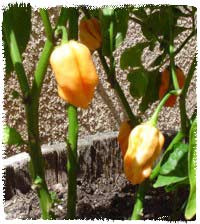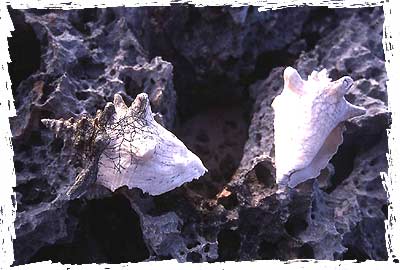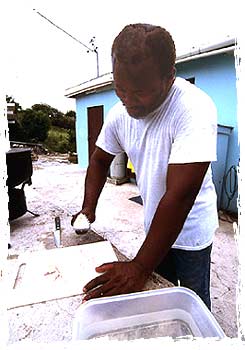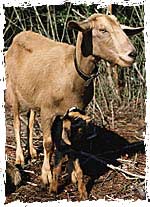By Patrick Holian
|
|
K.B.’s Goat Pepper Sauce K.B.’s Bird Pepper Rub Bahamian Conch Salad Doug’s Blackened Conch Goat Pepper Fried Chicken Goat Pepper Coconut Chicken
Story and Photos by Patrick Holian Illustration by Harald Zoschke |
Editor’s Note: Patrick’s story conjured up quite a memory for me, because the first chile pepper dish I ever ate was not in New Mexico, but rather in the Bahamas on a Windjammer cruise in 1971–a conch salad made with goat peppers. The heat wiped me out but I loved it. I’ve tracked down a recipe I consider to be very close to what I sampled and have added it to Patrick’s article. –Dave DeWitt
I was wandering the streets of Georgetown, a Bahamian backwater on Great Exuma. The clock was ticking. I had but a few hours before departing on an 8-day sailing adventure organized by Exuma-Bahamas Sailing Expeditions. The trip would take me to the Exuma Cays (pronounced “keys”), a chain of 365 stunning, coral islands that end at the Tropic of Cancer. This voyage was an expedition, not a cruise. Our group, sailing a flotilla of three tiny sailboats, would be camping on the deserted beaches of uninhabited cays.
|
|
Our Flotilla of Tiny
|
Because of this, time in Georgetown was precious. It would be my best opportunity to ask locals the question, “Why are they called goat peppers?” You see, Bahamians are known for using local Scotch bonnet peppers to heat up their cuisine. For some inexplicable reason, they call these pungent pods goat peppers. I had a burning desire to find out why.
I headed first to the straw market, a group of open-air stalls filled with t-shirts, straw hats, and wooden carvings. I had heard fresh produce could be found there. I approached two middle-aged women vendors with my inquiry. Two quick answers followed:
“Because they hot!”
“Because they ugly!”
“Are goats necessarily hot or ugly?” I countered.
“No, but that’s what we call them–goat peppers,” responded one vendor emphatically.
|
|
The Author in Quest of the Truth
|
Next, I queried an old man, the proprietor of an electronics and computer repair shop. Looking at the saws, hammers, and chisels piled on his bench top, I deduced that this establishment was better suited for boat building than for precision technical repair.
“Oh, I can’t tell you about goat peppers,” the old man said shaking his head and looking away. I was unsure if he just did not know about the subject or if he was hiding some arcane secret of island pepper lore. I left perplexed.
My next encounter involved two Bahamian women visiting from Nassau. Perhaps I would get a more sophisticated, urban response since, besides being the capital, Nassau is the largest municipality in the Bahamas. Wrong!
“Goat peppers? We call them that because they are big,” answered the daughter. The mother interjected, “Fifty years ago, before we had supermarkets in Nassau, people would just harvest peppers and herbs from wild plants that just grew on the island. We always called them goat peppers, but I believe the name came from Jamaica.”
I silently disagreed. The name must have Bahamian roots. I felt it in my bones. Undaunted, I headed to the Peace & Plenty Hotel to meet “the Doctor,” a mixologist with a reputation for being able to make over 300 different drinks without a bar book. I figured a man with that kind of ingredients knowledge should know the true meaning of the term goat pepper. After all, he was a doctor!
“Huh?” he said. “I have no idea. Would you like me to mix up a Misty Sea for you?”
No. Libations would only fog the path, blur the road, and inhibit my quest for the truth. Since the questioning was failing miserably, I decided to change my tactics and find some goat peppers. Perhaps getting near the source would reveal a clue. I made my way to the Exuma Markets, an indoor grocery store. While staring at the brilliant, orange pods in the produce cooler, a man called K.B. approached me. “Anything wrong?” he asked with concern. I imagine he doesn’t see too many tourists blankly staring into a pile of peppers.
|
|
Goat Peppers (center) at
|
“I’m trying to find out why these are called goat peppers.” I answered, holding up one for emphasis.
“Oh, that’s easy. Those peppers are so hot, they make you go ‘blaaaaaah,’ just like a goat with a stomach ache!”
Great. Another cutesie response. I did, however, learn more from this man named K.B. (a.k.a. Kenneth Bowe). He owns the Chat & Chill, a nearby eatery that serves hot and spicy local food. It turns out that Bahamians also use bird peppers–tiny, incendiary chiles the size of a small fingernail. K.B. logically explained that wild birds ingest these little rockets and spread the seed around by frequent aerial bombardment of avian excrement. Finally, I was offered a rational answer explaining the name of a pepper. Kenneth went on to give me detailed recipes that use goat and bird peppers, and suggested I eat at his restaurant upon my return.
|
|
Bird Pepper Bush, Staniel Cay
|
“Will you be there next Saturday?” I asked.
“Sir, I am the Chat & Chill.” He strutted away with a proud smile on his face.
The morning had rapidly turned to midday, and I departed Georgetown to meet my boat. Our group set off from the small northern village of Barre Terre by 3 p.m. and sailed across to Boysie Cay.
I set up my tent on a pristine spit of sand that jutted out into the water. After some rum and dinner, I retired to dreamland. That held true until the storm hit. Even though the official first day of hurricane season was still a week away, it was obvious that Mother Nature had failed to consult NOAA’s weather calendar. The wind blew. Lightning was everywhere. Rain traveled horizontally. At one point, I turned on my flashlight inside the tent only to find a fine spray of water filtering through the tungsten-halogen beam. It reminded me of the mist patio at my local saloon back home. This was trouble in paradise.
At next morning’s breakfast, I liberally poured local hot sauce on my eggs in hopes that the heat generated from the fiery fluid would help dry my water-soaked clothes.
|
|
Goat Pepper
|
“I see you like de peppah,” remarked Doug Gibson, our Bahamian guide who, along with his partner Mary Fingeroff, would be following our flotilla in a powerboat filled with provisions and sound advice. “If you like that, wait and see what I’m going to cook up tonight.”
We packed up and sailed our trusty Sea Pearl 21s into a gray sea. A squall to the south looked threatening, but as they day went on, the skies cleared a bit. We reached Lignum Vitae Cay an hour before sunset. Doug was already on the beach making dinner, and I could smell tantalizing aromas as we beached our boat.
|
|
Conch Shells
|
“Yeah, this is Doug’s Blackened Conch,” (pronounced konk), he said, stirring the pan. “It’s got a number of spices, but it’s the goat peppah that makes this dish zing.” I had chewed on conch before, a rubbery mollusk that islanders extract from large, conical seashells of the same name. But Doug’s conch was delightful. The goat pepper delivered the heat, and the other ingredients gave the dish a taste similar to a roux found in Cajun gumbo. We hungry sailors devoured all the conch in minutes.
It wasn’t until our flotilla landed on Little Farmers Cay two days later that I had a chance for more conch. Bahamians find it a delicacy and eat great quantities, often with hot peppers. That was the case as we entered the Ocean Cabin Restaurant & Bar at the top of the hill. I found owner Terry Bain behind the building “bruising” the conch.
|
|
Terry Bain, “Bruisin’ de Conch”
|
“You got to have this bruiser to make the conch tender,” he said holding a small hammer-like tool in his hand. It had grid-like, metal patterns of different sizes on each face of the 3-sided mallet. I watched as Terry beat the toughness out of the conch. We lunched on spicy conch fritters, mahi mahi and the house drink, the Ocean Cabin Special. This electric-blue blend was made of Curaçao, two kinds of rum, and several citrus juices. It tasted great and our motley crew eagerly indulged. We had been sailing for days and this was our first stop in “civilization.” We visited with a number of Little Farmers Cay’s fifty five residents before we sailed out that afternoon.
Several days later we ended our expedition at Staniel Cay. This was the largest town that I would see before leaving the Bahamas. It was now or never to find the answer to my question. I flagged down a local woman driving a golf cart, a popular mode of transportation on this tiny island.
“I’ve been in the Exumas for over a week now, and have yet to discover why Bahamians call goat peppers, goat peppers.”
|
|
Do Goats Eat Goat Peppers?
|
“You like de peppah?” She asked with unbelieving eyes. I nodded yes. “Oh, you should get togetha’ wid my sistah. She loves hot peppah. So do I, but she puts goat peppah’ on thick en makes de conch hot!”
Unfortunately, the sister was unavailable that day, but the golf cart lady urged me to walk up the hill to the Pink Store. “You can’t miss it. It’s right next door to the Blue Store. Flo may be able to answer your question. Ask her, darlin’.”
When I arrived, I saw an older woman sitting in the shade, weaving a basket out of palm fronds. “Are you Flo?”
“I’m Flo Smith,” she said putting down her work.
“I was told that you might be able to tell me why goat peppers are called that.”
Flo started laughing. “I have your answer. Dey call dem goat peppers because dey so hot. Dem peppers knock you out like an ol’ billy goat hittin’ yo’ head!”
Flo and I stood there laughing. It was the best explanation that I had heard during the trip. I bought some frozen goat peppers and some bird peppers that Flo had picked off the bush that grew right outside the Pink Store. With bag in hand, I sped off to find Doug. Perhaps he just might be persuaded to make some more of his blackened conch, just one last time.
Travel Notes
Getting There: American Airlines from Miami to Georgetown.
Activities:
Sailing the Exuma Cays is a remarkable way to see these islands. Exuma-Bahamas Sailing Expeditions can get you there. Log on to www.exuma-bahamas.com
For those who prefer paddling, Starfish Adventures offers sea kayaking trips. Visit www.kayakbahamas.com
Lunch:
The Chat & Chill Beach Club on nearby Stocking Island is just across the harbor from Georgetown. Bum a dingy ride over and have K.B. make up some hot and spicy fare.
Lodging: If you want to experience the Bahamas the way they were 50 years ago, drive south from Georgetown to Little Exuma Cay. Cross the one-lane bridge and travel to Forbes Hill, home to the Le Shante Beach Resort. For more info, log on to http://exumaaccommodation.com/
This intimate, 5-unit lodging is located on the most beautiful beach I have seen in the West Indies: gin-clear, aqua-blue water runs along a very private, 100-yard, crescent-shaped beach. Most units have kitchens and range from $90-110/night depending upon season. Dwight will cook fresh fish for you upon request.
Recipes
Note: Fresh conch is found only in a few tropical fish markets in the U.S., but frozen conch is commonly available throughout the country. Call the largest seafood supplier in your area and they can assist you. Make sure that you tenderize it thoroughly by pounding it. Goat peppers are available occasionally in Florida markets, but any type of habanero can be substituted with no change in heat or flavor.
It’s really exciting to discover a unique but authentic island hot sauce recipe! This makes enough sauce to last for maybe a year in the refrigerator. Note that it is uncooked. Grind or process the peppers in a well-ventilated space, or preferably outdoors. Warning: the heat level of this sauce is off the scale, so use it sparingly. The Bahamas have an extensive sea salt extraction operation, so that is the preferred salt.
-
1 pound goat peppers (habaneros), seeds and stems removed, halved
-
½ pound garlic, peeled
-
White vinegar as needed
-
Sea salt to taste, about 1 teaspoon
-
Olive oil as needed
In a food processor, combine, in small batches, the goat peppers and garlic and puree into a paste. Make sure that the peppers and garlic are well mixed. Place in a large jar and cover with vinegar. Add the sea salt and mix well. Then pour 2 inches of olive oil on top of the mix. K.B. says the oil keeps the air out and preserves the pepper.
Yield: About 1 quart
Heat Scale: Extremely hot
Another incredibly hot condiment, this rub should be used sparingly. You can use any piquins, chiltepins, tabascos, or other small, hot chiles in this recipe. It is good to coat fish to be grilled or conch to be fried up in oil. Rub the mixture lightly onto the fish fillet or conch. Squirt lime juice over the food. Then seal in a zip bag for 2 to 3 hours before cooking.
-
1 handful (½ cup) bird peppers, fresh or dried
-
1 teaspoon sea salt (or more to taste)
-
2 teaspoons fresh thyme, minced
In a mortar, grind together all the ingredients into a paste.
Yield: About ½ cup
Heat Scale: Extremely hot
Fresh conchs are best, of course, but frozen conchs can be substituted. Serve over spinach or romaine lettuce or in a avocado half or a tomato star.
-
4 large conchs, washed, pounded thoroughly, and cut into ¼-inch cubes
-
Salt to taste
-
1/3 cup freshly squeezed lime juice, Key lime preferred
-
1/3 cup freshly squeezed lemon juice
-
1 or more goat peppers (habaneros), seeds and stems removed, crushed in a mortar
-
½ cup finely diced celery
-
1/4 cup finely diced green bell pepper
-
1/4 cup finely diced red bell pepper
-
½ cup finely diced red onion
-
1 cup finely diced ripe tomatoes
-
Lime juice as a garnish
-
Minced goat peppers as a garnish
Place the conch in a large bowl and sprinkle with the salt.
Mix the lime and lemon juices together in a small bowl. Add the crushed goat pepper to the juices and pour over the conch. Add the celery, bell peppers, onion, and tomatoes and mix gently with a wooden spoon.
Serve over greens or in a avocado half or tomato star with extra lime juice and goat peppers if desired.
Yield: 8 servings
Heat Scale: Hot
I’m winging it here, as Doug Gibson, of course, had no written recipe. I watched carefully but am guesstimating the ingredient amounts. But what the hell, he was cooking on the beach! The conch does not burn, it just turns quite dark because of the seasoning.
-
1/4 cup vegetable oil
-
1 teaspoon minced fresh rosemary
-
1 onion, minced
-
½ green bell pepper, finely diced
-
2 tablespoons commercial blackening seasoning
-
1 goat pepper (habanero) seeds and stems removed, minced
-
½ teaspoon sea salt
-
1/4 teaspoon black pepper
-
2 conchs, pounded flat and cut in half
-
Lime quarters for garnish
In a large skillet, heat the vegetable oil until hot and add the rosemary, onion, and bell pepper and saute for 3 minutes, stirring constantly. Add the blackening seasoning, goat pepper, sea salt, and black pepper and saute for 2 more minutes. Add the conch pieces, 2 at a time, and cook over high heat until they turn dark, about 2 or 3 minutes per side. Remove and serve garnished with lime quarters.
Yield: 4 servings
Heat Scale: Medium-hot
Here is a typical Bahamian fried chicken recipe that varies only slightly from island to island, and there are hundreds of islands. Serve with potato salad and a rum punch.
-
1 chicken, cut up
-
1/4 cup K.B.’s Goat Pepper Sauce or your favorite habanero hot sauce
-
Salt and pepper to taste
-
2 eggs, beaten
-
2 tablespoons evaporated milk
-
Vegetable oil for deep-frying
-
Flour as needed
-
Breadcrumbs as needed
-
Additional goat pepper sauce or habanero hot sauce
Combine the chicken, pepper sauce, and salt and pepper in a zip bag. Marinate in the refrigerator for 2 hours. In a bowl, combine the eggs and the evaporated milk. Heat the oil until hot in a deep-fryer. Remove the chicken and dip in the flour, then in the egg mixture, and finally in the bread crumbs. Place in the deep-fryer and cook until golden brown. Serve with additional sauce as desired.
Yield: 4 to 6 servings
Heat Scale: Medium to hot
Coconut is combined with almost everything in the Bahamas. Its water is used in drinks, the flesh is made into milk and cream, and it is also grated and dried to use in various dishes.
Purchase the freshest coconut possible when preparing this dish. Choose one that’s heavy in size and sounds full when shaken. One fruit will yield 3 to 4 cups of grated coconut.
-
1 onion, finely chopped
-
½ cup butter
-
1 chicken, cut into 8 pieces
-
1 goat pepper (or habanero), seeds and stem removed, minced
-
Salt and black pepper to taste
-
2 teaspoons massala (available in Asian and West Indian markets)
-
1 tablespoon sugar
-
½ teaspoon saffron
-
2 cups chicken stock
-
1 cup freshly grated coconut
In a large frying pan, soften the onion in the butter and brown the chicken pieces. Add the chile pepper, salt, pepper, massala, and the sugar, stirring until the chicken is golden. Remove the chicken from the pan and keep warm.
Add the stock to the pan and heat slowly for 15 minutes. Put back the pieces of chicken and simmer, uncovered, over low heat for 25 minutes.
Add the coconut and simmer for another 10 minutes. If possible, serve each portion separately in half a coconut shell.
Yield: 4 servings
Heat Scale: Medium
*

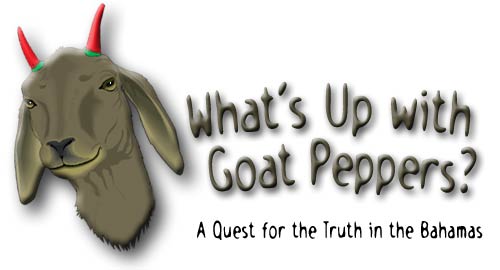




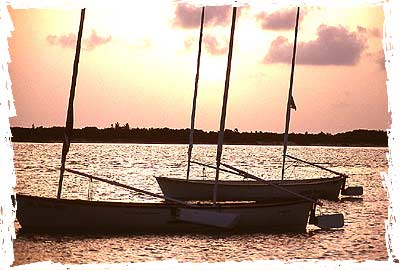
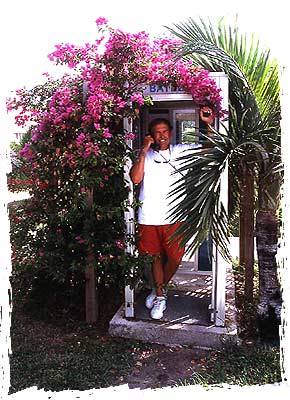
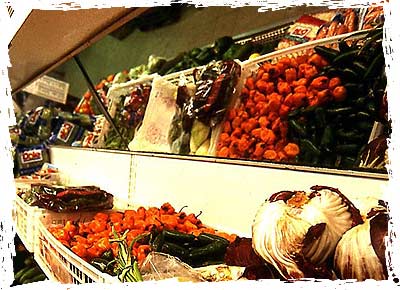

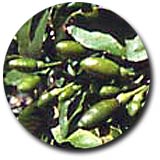 Bird Pepper Pods
Bird Pepper Pods